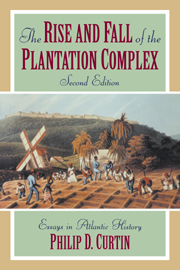Book contents
- Frontmatter
- Contents
- Preface
- Preface to first edition
- Beginnings
- Seventeenth-century transition
- Apogee and revolution
- 9 The slave trade and the West African economy in the eighteenth century
- 10 Atlantic commerce in the eighteenth century
- 11 The Democratic Revolution in the Atlantic basin
- 12 Revolution in the French Antilles
- Aftermath
- Appendix
- Index
12 - Revolution in the French Antilles
Published online by Cambridge University Press: 05 June 2012
- Frontmatter
- Contents
- Preface
- Preface to first edition
- Beginnings
- Seventeenth-century transition
- Apogee and revolution
- 9 The slave trade and the West African economy in the eighteenth century
- 10 Atlantic commerce in the eighteenth century
- 11 The Democratic Revolution in the Atlantic basin
- 12 Revolution in the French Antilles
- Aftermath
- Appendix
- Index
Summary
The slave rebellion that began in 1791 and led to the independence of Haiti in 1804 was the key revolution in the fall of the plantation complex. It not only ended the slave regime on the French half of the island; it also made Haiti the first European colony with a non-European population to achieve independence and formal, if somewhat grudging, recognition as a member of the community of Western nations.
The Haitian revolution was also the most violent step toward the end of the plantation complex. Its only rival in violence was the American Civil War some seventy years later; but North American plantations were marginal to the complex, and the American Civil War was fought about other issues as well as slavery. The French Antilles, on the other hand, were central to the slave regime in the Caribbean, and the Caribbean was central to the whole plantation complex in the late eighteenth century.
Geography of the French Antilles
The large colony of Saint Domingue was the heart of the French Caribbean as of the 1780s, even more so than Jamaica was in the British Caribbean. But Saint Domingue was not a single social and economic unit in the same way Jamaica was. It was divided into three separate provinces that communicated with France and with one another by sea. Each province was socially and economically distinct; each was focused on its own urban center or centers.
- Type
- Chapter
- Information
- The Rise and Fall of the Plantation ComplexEssays in Atlantic History, pp. 158 - 170Publisher: Cambridge University PressPrint publication year: 1998

